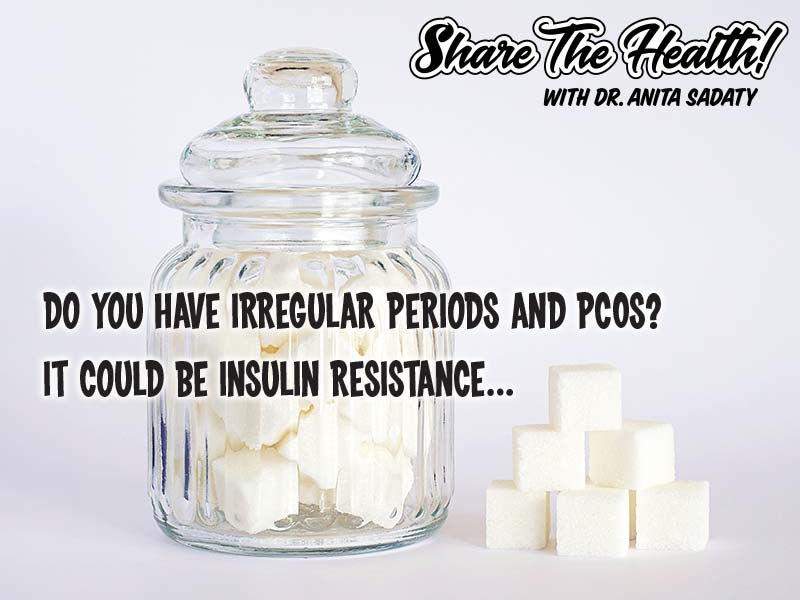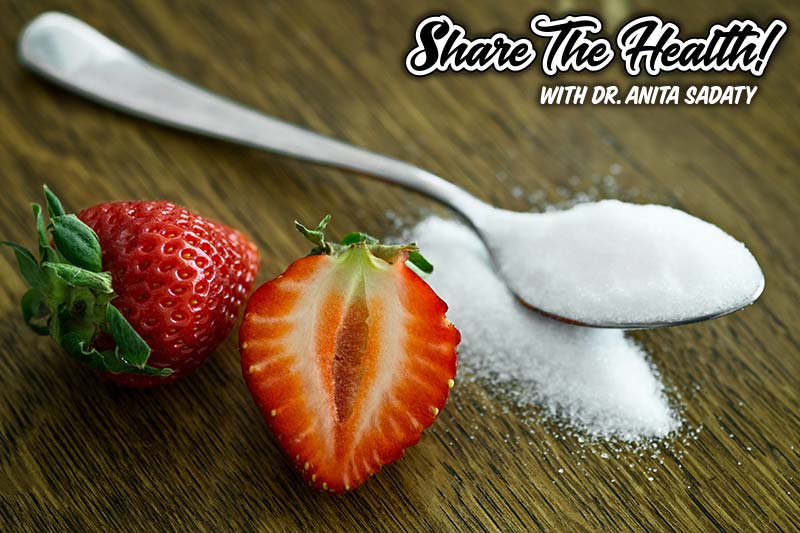
When Insulin Drives Irregular Periods and PCOS
Seventy percent (70%) of women and teens with PCOS (Polycystic Ovarian Syndrome) – the most common cause of period irregularities – have sugar and insulin imbalance. This is known as insulin resistance (IR). In these cases, fixing IR is key to healing PCOS and your hormone imbalance. If you normalize your blood sugar levels, and increase your tissue sensitivity to circulating insulin, you can fix your hormone imbalance. I know you know this…but often we think of “sugar” intake as eating cake and candy. AKA the breakfast sandwich of champions. But often we don’t realize that this also means processed carbs like pastas, breads or high carb beans and legumes or even too much fruit. We often think of “healthier versions” of carbs as no problem. Not so…
So…What exactly is insulin resistance, and how does it drive PCOS?
This refers to your body’s reduced ability to respond to insulin. Chronic high blood sugar raises insulin, which in the case of IR eventually remains elevated. Insulin receptor sites shut down after constant bombardment with excess sugar and carb exposure. This is insulin resistance. Insulin essentially has nowhere to go, so it remains high in your bloodstream, and mixed with the right genetics creates the perfect storm for hormone imbalance and PCOS.
High insulin:
- Causes your ovaries to produce higher levels of testosterone
- Creates inflammation
- Increases the toxic load for your liver and blocks your ability to detoxify
These are all things we want to get rid of in PCOS!
Not all women with high insulin respond in this way because your genes play a role in whether or not you develop insulin resistance and PCOS. From an ancestral point of view, there are a group of genes collectively referred to as “thrifty” genes that are responsible for the enhanced ability to store fat and reduce metabolism in order to survive periods of scarcity and famine. This was of course very advantageous for survival thousands of years ago, however, in the modern age of convenience foods, three meals plus unlimited snacks per day, and never going hungry, this gene has become the harbinger of Type 2 diabetes, heart disease, Alzheimer’s and metabolic syndromes, like PCOS.
When should you suspect insulin resistance as your main driver of PCOS?
The symptoms that typically come with this particular driver include:
- Excess weight and obesity, with fat typically located around your middle (apple-shaped), although you can have blood sugar dysregulation and be of normal weight or thin!
- Fatigue and loss of energy
- Sugar cravings, feeling light-headed or dizzy if you skip a meal or become hungry
- Sleepiness after a carb-rich meal
- Hair loss on your scalp, especially at your temples and top of your head
- Dark skin changes or patches on your neck, armpits, or groin
- “Male pattern” hair growth on your face, chin, chest or inner thighs
- Joint and muscle aches and pains
- High cholesterol and triglyceride levels (dyslipidemia)
- Pre-diabetic or diabetic diagnosis
- Personal history of diabetes in pregnancy or family history of diabetes
Causes of insulin resistance:
- Standard American Diet (SAD) — high processed foods, high sugar, high fructose, low vegetables, alcohol, and trans-fat intake
- Frequent snacking
- Smoking
- Stress
- Hormonal birth control
- Sleep deprivation
- Unhealthy gut bacteria (dysbiosis) or yeast overgrowth
- Magnesium deficiency
- Environmental toxins
Does this apply to you? Are you one of the 70%? If so, step up your game in these ways:
Here are the main lifestyle adjustments we recommend you make to reset your metabolism and balance your hormones.
NOURISH
We recommend a “3/12 eating style” — this means three meals a day with balanced macronutrients each meal (proteins, carbs and fats) and keeping your eating window to 12 or less hours a day. That gives you a 12 hour fast overnight (mostly while sleeping) to try to get the insulin receptors emptied and more sensitive. Avoiding snacks would be ideal, however, if you have one snack in the day, make sure you are balancing your protein, carbs and fats there too!
Here is an example daily menu:
- Breakfast: eggs with turkey bacon, sauteed veggies OR 1-2 scoops of a clean protein powder, with almond or coconut milk, ½ an avocado and a handful of frozen berries. I like the Glycemacore powder which is sugar balancing and supports insulin sensitivity. Great for stopping carb cravings and tastes great.
- Lunch: mixed green salad with 4 to 6 ounces of protein (fish, chicken, beef, turkey, eggs) with 2-3 tablespoons of olive or avocado oil for fat with lemon juice, salt and pepper. Add in any veggies you like, 1-2 tablespoons of sliced almonds or nuts of your choice for additional fats.
- Dinner: grilled, baked, steamed, slow cooked or low flame sauteed fish/poultry/beef/lamb with sauteed or roasted veggies (broccoli,cauliflower, zucchini, peppers) with a ¼ of the plate of starches like rice, potato, quinoa or fruit.
- Snack: Ideally if your meals are dialed in you can avoid snacking which raises your insulin levels and keeps you needing MORE to eat actually. But a great snack choice would be sliced apple with nut butter, hummus with veggie sticks, avocado with cucumber slices or carrot chips, nuts with whole fat yogurt.
If this feels too complicated for you, just eat whole foods instead of processed foods, and significantly reduce grains, and you’ve accomplished 90% of the battle. Whole foods rarely come in a box with labels. Remember, there is no nutrition label on a red pepper, a broccoli stalk, or a piece of fresh wild salmon.
Consider a blood sugar balancing support supplement: Glucosupreme herbal 1-2 capsules before meals to stabilize blood sugar naturally. This is also helpful to reduce carb cravings throughout the day.

MICROBIOME
Nourish your beneficial bacteria with microbiome boosting pre and probiotic foods, to support healthy growth and “crowd control” of pathogenic bugs. This will directly reduce gut inflammation and dysbiosis, which are directly related to insulin resistance. Countless studies correlate a healthy, robust, diverse GI microbiota with the ability to control IR and maintain a lean body weight. This is KEY. The probiotic we recommend for IR is UltraFlora Acute Care.
Here is a list of microbiome boosting foods to include — aim for three a day and rotate through different ones every day!
- Veggies: Artichokes, asparagus, beets, bell peppers, broccoli, brussel sprouts, cabbage, carrots, cauliflower, chicory root, cucumbers, radishes, dandelion greens, fennel, garlic, hearts of palm, jicama, leeks, onions, peas, seaweed, sweet potatoes, yams
- Fruits: Apples, avocado, berries, cherries, kiwi, mango, olives, pears, plantains, tomatoes
- Other: chia seed, coconut flour, dark chocolate, flax, ginger root, hemp, honey, legumes, pumpkin seeds, quinoa and wild rice.
When all else fails, or you can’t get these in on any given day, consider adding megaprebiotic or indigo greens or polyprebiotic powder blends one scoop of any one of these powders to feed your beneficial bacteria the food they want. It’s great as a back up. Go slow though! You never know how feeding your microbiome can go. The last thing we want is for you to be known as “Sir Fartsalot” behind your back. Or in New York, to your face!
MOVEMENT
Interval cardio and strength training will improve insulin sensitivity. Include restorative exercise to improve your body’s optimal stress hormone balance.
- Do cardio interval (burst) exercise to create the right hormones for weight loss, instead of extended medium pace cardio. This could be a jog or sprint for 30 seconds followed by a minute of walking or light jogging. Try this for 10 to 15 minutes. Work up to it.
- Incorporate strength training to increase your resting metabolic rate. Muscle burns more than, well “not” muscle.
- Stand more and sit less. We’ve all heard that sitting is the new smoking. I’ll say binge watching netflix is the new crack. But, back to my point. Simply standing significantly improves metabolic rate. Sitting does nothing. Consider a standing desk, and a step counter.
RESTORE WITH SELF CARE
Stress reduction and self care is critical to lowering cortisol. Cortisol spikes up blood sugar levels and even with a flawless eating plan can cause sugar and insulin disruption.
Take A Me Break. Do something for yourself that is stress busting. A massage, an acupuncture session, a walk in nature, dancing, singing, drawing, meditating — whatever creates calm and enjoyment in your life. Check out my article about “Bringing the Zen” that includes action steps to lower stress and this post about my top three meditation apps.
Sleep well, and enough. Aim for 8 hours of sleep and make it restful. Why? Staying up and not getting enough rest doesn’t allow your system to reset and restore. This leads to uncontrolled stress hormones and high cortisol — both of these cause and are caused by problems with sugar and insulin. Chronic stress causes sky-high adrenaline and cortisol, which mobilizes sugar for the “fight or flight” response. High cortisol drives abdominal weight gain. Shut down high cortisol by taking care of your adrenals and your stress.
RENEW
✚ Reduce toxic exposures. Hydrate well. Poop daily.
Lowering your toxin exposures will lower inflammation and optimize your liver (detox) function. Check out my previous post entitled Why you should detox on the daily for tips and tricks to lowering toxins. When your detox pathways run smoothly, your energy producing mitochondria (think of these guys as your home electricity system) can power your body to burn fat effectively. If detox is backed up, mitochondria back up and cannot burn fat well. One of my favorite detox support supplements for PCOS and high sugar insulin imbalance is Dim Detox. This is great if you have symptoms of estrogen dominance (PMS, acne, unwanted hair growth, heavy periods when you get them, breast tenderness and fluid retention. Take 2 capsules daily for three months to see how it impacts your hormones and your blood sugar.
That does it. If you want to explore this further or want to dig deeper into your health problems, then contact our office for details about all the health restoring options we have available.
Please Share the Health if you liked what you read!!!
For more information about my wellness programs and my practice, check out my website drsadaty.com. Hey Look! You are already here…
Ready for the legal disclaimer? Information offered here is for educational purposes only and does not constitute medical advice. As with any health recommendations, please contact your doctor to be sure any changes you wish to consider are safe for you!